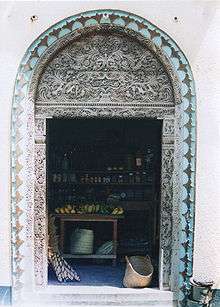Swahili culture
Swahili culture is the culture of the Swahili people inhabiting the Swahili Coast. This littoral area encompasses Tanzania, Kenya, Uganda and Mozambique, as well as the adjacent islands of Zanzibar and Comoros and some parts of the Democratic Republic of Congo and Malawi. They speak Swahili as their native language, which belongs to the Niger-Congo family.
Swahili culture is the product of the history of the coastal part of the African Great Lakes region. As with the Swahili language, Swahili culture has a Bantu core that has borrowed from foreign influences.
History
The Swahili culture and language began to take form around the 1st-3rd century CE, as a consequence of the Swahili people settling and creating city-states on the Swahili Coast and nearby islands. Around the 8th century is when the Swahili people really became important in history; they began trading with the Arab, Persian, Indian, Chinese, and Southeast Asian people. This is known as the Indian Ocean Trade. The culture was influenced by Arabic, Persian, Indian, and Chinese culture as a consequence of long-distance trading routes crossing the Indian Ocean. Beginning in Kenya and Tanzania, the Swahili culture eventually spread to Mozambique.[1]
During the 10th century, several city-states flourished along the Swahili Coast and adjacent islands; some examples are Kilwa, Malindi, Gedi, Pate, Comoros and Zanzibar. These early Swahili city-states were Muslim, cosmopolitan and politically independent of each other.[2] They all competed against one another for the best of the Great Lakes region's trade business. The chief exports of these cultures were salt, slaves, ebony, gold, ivory, and sandalwood . These city-states began to decline towards the sixteenth century, mainly as a consequence of the Portugueses' advent. Eventually, Swahili trading centers went out of business and commerce between Africa and Asia on the Indian Ocean collapsed.[3]
Aspects of Swahili culture are diverse due to its many influences. For example, Swahili cuisine has influences from Indian and Arabic cultures. There are also alterations to certain dishes due to religious reasons.[4] Some food items common in everyday lives of the Swahili are fish, tropical fruits, and exotic spices.
Historic Swahili culture was intensely urban and dominated by a strict class structure.[5]
Arts and crafts
Another cultural aspect of the Swahili is their use of arts and crafts, which they find significance in. When creating art, they express themselves through creativity as well as through shape and function. Some multicultural influences can be seen in Swahili art, furniture, and architecture.[4] They do not often use designs with images of living beings due to their Muslim heritage. Instead, Swahili designs are primarily geometric. There are important clothes that are part of their arts and crafts such as the Kanga. The Kanga is not only a rectangular piece of cloth but is an artifact of the Swahili culture. The cloth should be made with extreme care. If the cloth doesn’t match the season then it doesn’t deserve to be a Kanga and can be used as a baby diaper or an apron for the kitchen. Even though the Kanga is quite cheap, it is still a main part of Swahili culture. The Kanga is made in Tanzania and is mostly appealing to woman rather than men but men are not restricted to using it. The cloth is used as a sling to carry babies, melons on their heads and can also be used as a kitchen apron.
Music
The most typical musical genre of Swahili culture is taarab (or tarabu), sung in the Swahili language. Its melodies and orchestration have Arab and Indian influences (although Western instruments, such as guitars, are sometimes used).[4][6]
In the 20th century several musical genres have emerged in the Swahili world, that are derivatives of Western popular music. One major example is muziki wa dansi, which is the Tanzanian counterpart of Congolese soukous (rumba). In the last decades of the century, most Swahili music has been in the afropop vein. This includes several local derivatives of American hip hop (e.g. bongo flava).
Literature
See also
References
- ↑ Swahili Culture. 2006. UNESCO World Heritage Centre. Retrieved on 2009-04-01
- ↑ Swahili Information. Art & Life in Africa. 1998. The University of Iowa. Retrieved on 2009-04-01
- ↑ Richard Hooker (1997). "Civilizations in Africa - The Swahili Kingdoms". wsu.edu. Washington State University. Archived from the original on January 4, 2011. Retrieved 24 April 2015.
- 1 2 3 Dishes, Mwambo.com Retrieved on 2009-04-01
- ↑ Garlake, Peter, Early Art and Architecture of Africa, p. 169, Oxford, 2002
- ↑ Tarabu, MusicWeb Encyclopedia of Popular Music

